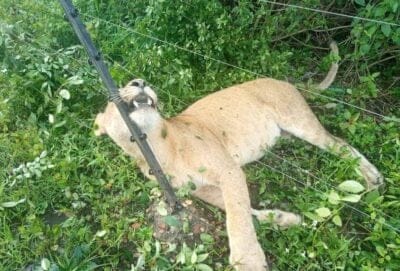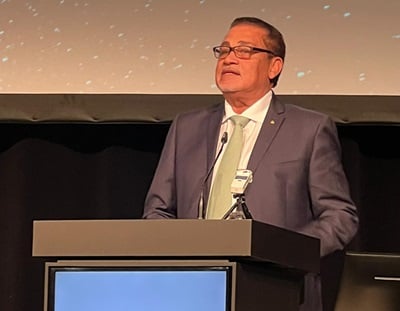On April 26, 2022, three lionesses – one adult and two sub-adults – were electrocuted around Kigabu Village in Katunguru, Rubiriz district, surrounding Queen Elizabeth National Park in western Uganda. The lionesses were found dead on an electric fence at Irungu Forest Safari Lodge with their jaws trapped in between the electric wiring.
A statement from Bashir Hangi, Communications Manager of the Uganda Wildlife Authority (آئوا) following the incident reads in part: “Much as the actual cause of death is yet to be established, we suspect electrocution. A post mortem on the dead lionesses will be done to confirm their actual death. The public will be informed about the outcome of the post-mortem. Rubirizi Police was informed, and they have already visited the scene of this unfortunate incident to aid investigations.”
According to preliminary investigations, the lodge had, unknown to the authorities, allegedly deployed makeshift methods to tap the direct current from the main lines to deter wildlife that wandered close to the lodge, leading to the deaths.
In a disclaimer to the incident, “Space for Giants,” issued a press release following the incident stating: “Space for Giants fences are designed to do no lasting harm to any animal or person and are expressly non-lethal. Their purpose is to keep wildlife, especially elephants, away from peoples crops or property so they are more likely to tolerate living near wild animals that can otherwise ruin their livelihoods.
“Although the fences deploy very high voltages, they use a very low current that pulses on and off. This means that any animal or person that encounters our fences receives a strong but not deadly shock and can always pull back to be freed from the current.
“In close to two decades installing these fences in many locations across East Africa, including areas populated with lions, the only incidences of animals failing to survive an encounter with the fence have been species with long horns that became entangled with the wire and failed to free themselves. Such incidences were rare and so regretted.
“Space for Giants a conservation organization working across 10 countries in Africa to protect and restore nature and bring value to local people & national governments, has supported UWA with funds for construction of بجليءَ جي باهه in the Queen Elizabeth Conservation Area (QECA) and Murchison Falls, a key human wildlife conflict intervention for the Murchison Falls Conservation Area (MFCA).
Complimenting Space For Giants, Andrew Lawoko, a landed owner based at Karuma Falls within the Murchison Falls Conservation Area, advises that “the voltage that is used for animals in the park should be strong enough to deter them but not as strong as to electrocute.”
One tour operator, name withheld, said of the incident:
“There is no year that passes without reports of lion killings in Queen Elizabeth National Park.”
“I think UWA should wake up; they should trace for the memorandum of understanding that was signed by the time these fishing villages were being gazetted. Katunguru was gazetted in 1935 under [the] Game Department; the agreement included the following among others: No introduction of domestic animals, no growing crops, regulating the population, etc. It was gazetted for the purpose of fishing only. Other fishing villages that had two economic activities, i.e., fishing and salt extraction included Katwe and Kasenyi. Now that the agreement is no more and other activities like tourism activities including building tourism facilities have come in, it’s now high time to review the agreement or initiate other measures to be taken. Ishasha and Hamukungu communities need much sensitization and review conservation approaches if they are to live in harmony with wildlife.”
Several other stakeholders in the tourism sector are less forgiving in pouring out their anger on social media over the alarming rate at which lions are dying due to human wildlife conflict including calling for a boycott of the property that erected the fence and that they should be held to account.
Their frustrations are not far-fetched, following several incidents resulting in lion deaths. In April 2018, 11 lions, including 8 lion cubs, were poisoned by herdsmen to avenge for the killing of their cattle by lions within the park causing an uproar both locally and internationally.
In March 2021, 6 lions were found dead in the Isasha sector of the park with most of their body parts missing. Eight dead vultures were also found at the scene which points to possible poisoning of the lions by unknown people.
In the latest incident, just barely 2 1/2 weeks ago, a stray lion on a rampage in Kagadi community, north of Kibale Forest National Park was shot, after it had killed a number of livestock.
هن آرٽيڪل مان ڇا وٺو:
- Several other stakeholders in the tourism sector are less forgiving in pouring out their anger on social media over the alarming rate at which lions are dying due to human wildlife conflict including calling for a boycott of the property that erected the fence and that they should be held to account.
- Complimenting Space For Giants, Andrew Lawoko, a landed owner based at Karuma Falls within the Murchison Falls Conservation Area, advises that “the voltage that is used for animals in the park should be strong enough to deter them but not as strong as to electrocute.
- “In close to two decades installing these fences in many locations across East Africa, including areas populated with lions, the only incidences of animals failing to survive an encounter with the fence have been species with long horns that became entangled with the wire and failed to free themselves.























